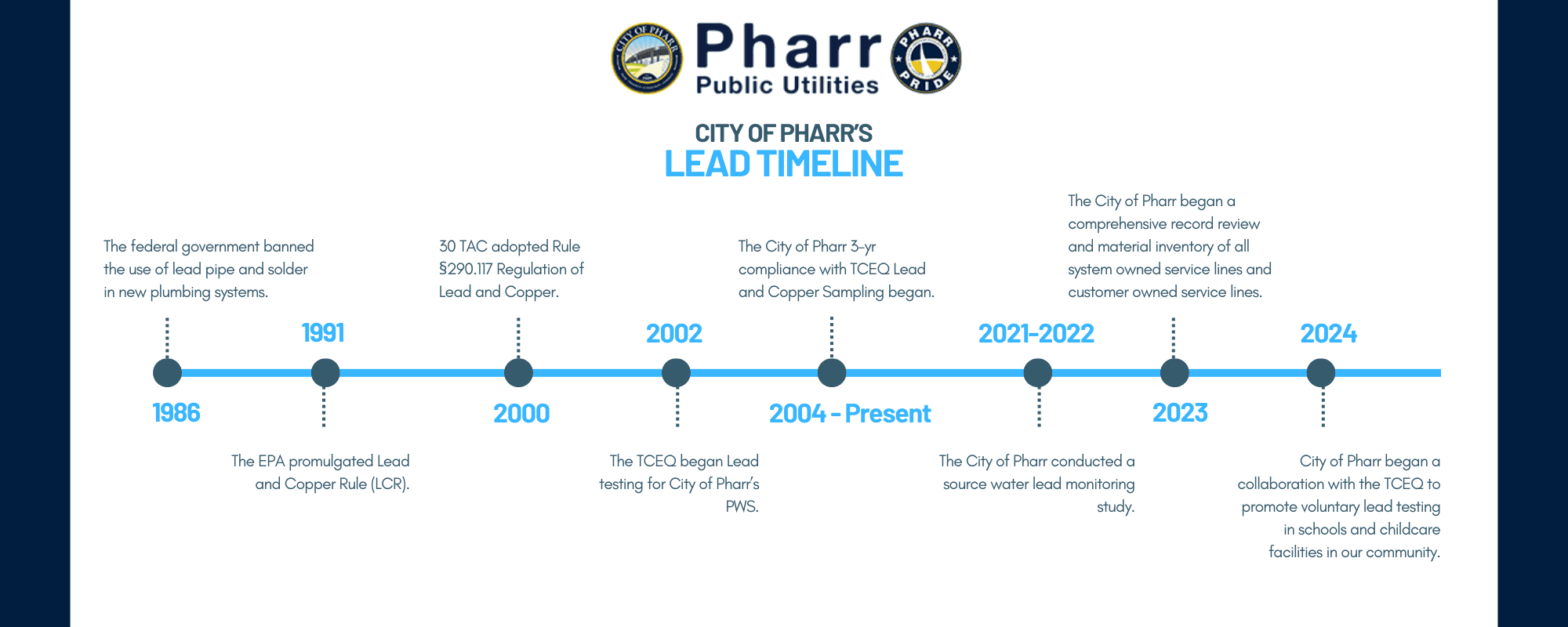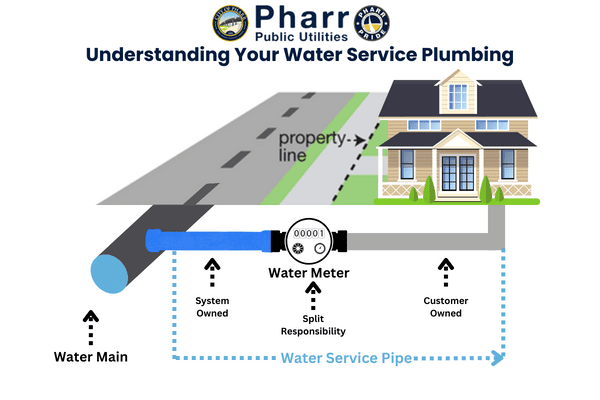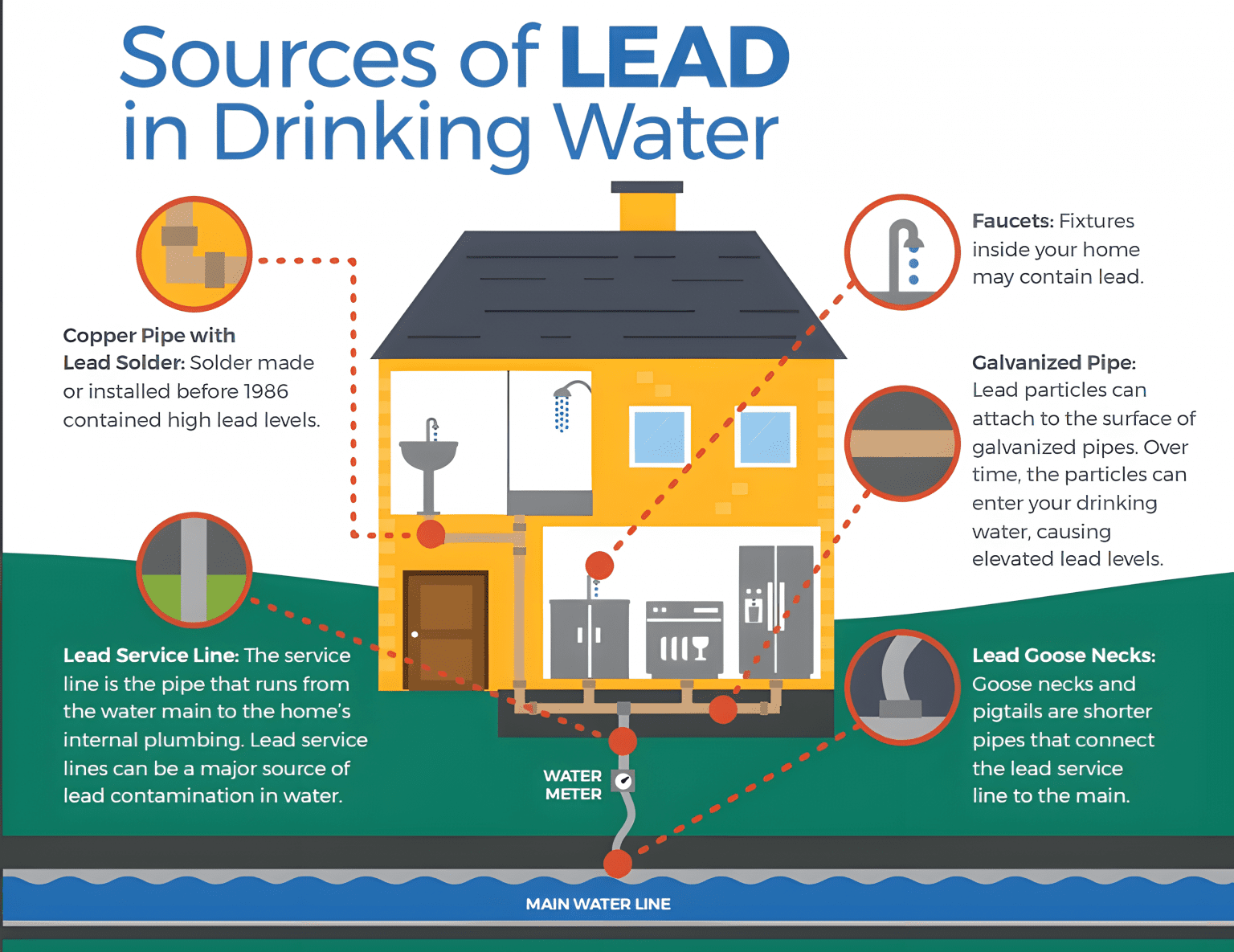Learn About Lead
City News
Learn About Lead in Drinking Water
The City of Pharr Water continues to meet all local, state, and federal drinking water standards and monitoring requirements for lead and other chemicals in drinking water. The Texas Commission on Environmental Quality (TCEQ) Drinking Water Watch has all historical data of the chemical results tested for compliance for all Public Water Systems, including those for the City of Pharr. Additionally, the City of Pharr updates their Water Quality Report (Consumer Confidence Report) Annually on our website for public access. Lastly, when the federal bans went into effect, the City of Pharr implemented local ordinances prohibiting lead in new plumbing systems.
The City of Pharr’s Lead Timeline

Understanding Your Water Service Plumbing
Property owners are responsible for identifying and replacing lead piping inside the home and along their property out to the water meter.

How Lead Gets Into Drinking Water
Lead can enter drinking water when plumbing materials that contain lead corrode, especially where the water has high acidity or low mineral content that corrodes pipes and fixtures. The most common sources of lead in drinking water are lead pipes, faucets, and fixtures. In homes with lead pipes that connect the home to the water main, also known as lead services lines, these pipes are typically the most significant source of lead in the water.
Lead pipes are more likely to be found in older cities and homes built before 1986. Among homes without lead service lines, the most common problem is with brass or chrome-plated brass faucets and plumbing with lead solder.

TCEQ Lead Testing in School and Child Care (LTSCC) Program
The TCEQ is offering a FREE statewide program to help eligible School administrators or childcare participants conduct voluntary sampling and analysis for lead in drinking water at their schools and childcare facilities. The City of Pharr collaborates with the TCEQ’s LTSCC Program to promote and share with our community the benefits of enrolling in this program. For more information about this program visit Voluntary Lead Testing in School and Child Care Drinking Water – Texas Commission on Environmental Quality.
City of Pharr Service Line Inventory
On December 2021, The Biden-Harris Administration announced the Lead Pipe and Paint Action Plan that Accelerates Bipartisan Infrastructure Law Investments to Replace All Lead Pipes across America in Next Decade.
The Environmental Protection Agency (EPA) announced final revisions to the National Primary Drinking Water Regulations for lead and copper under the authority of the Safe Drinking Water Act on December 16, 2021. This includes requirements for drinking water systems to establish an initial detailed service line inventory.
The City of Pharr has achieved 68% service line material identification
City of Pharr Initial Detailed Service Line Inventory (PDF)
The customers who are pending identification of service line material will be receiving a notification via mail stating, “a portion of or the entire service line material is unknown and may be lead or galvanized requiring replacement.” We ask for your collaboration to help us identify the service line material installed in your house or business by filling out the following form:
Customer – Owned Service Line Form
On October 8th, 2024, the administration issued a final rule under the Lead Pipe and Paint Action Plan requiring drinking water systems across the country to identify and replace lead pipes within 10 years. A historic effort to remove lead lines introduced before 1986 when the legislative effort in banning and removing lead started under the Safe Drinking Water Act. The City of Pharr will continue with efforts to identify the remaining service lines to ensure resources going into the City’s Replacement Plan are prioritized accordingly.
Health Effects of Lead
Exposure to lead can cause serious health effects in all age groups. Infants and children can have decreases in IQ and attention span. Lead exposure can lead to new learning and behavior problems or exacerbate existing learning and behavior problems. The children of women who are exposed to lead before or during pregnancy can have increased risk of these adverse health effects. Adults can have increased risks of heart disease, high blood pressure, kidney, or nervous system problems.
Steps you can take:
- Use your filter properly. Using a filter can reduce lead in drinking water. If you use a filter, it should be certified to remove lead. Read any directions provided with the filter to learn how to properly install, maintain, and use your cartridge and when to replace it. Using the cartridge after it has expired can make it less effective at removing lead. Do not run hot water through the filter. For more information you can use the EPA’ tool to identify certified filters and look at the EPA’s fact sheet on home filtration
- Clean your aerator. Regularly remove and clean your faucet’s screen (also known as an aerator). Sediment, debris, and lead particles can collect in your aerator. If lead particles are caught in the aerator, lead can get into your water.
- Use cold water. Do not use hot water from the tap for drinking, cooking, or making baby formula as lead dissolves more easily into hot water. Boiling water does not remove lead from water.
- Run your water. The more time water has been sitting in your home’s pipes, the more lead it may contain. Before drinking, flush your home’s pipes by running the tap, taking a shower, doing laundry, or doing a load of dishes. The amount of time to run the water will depend on whether your home has a lead service line, the length and diameter of the service line and the amount of plumbing in your home.
Additional Resources
Information on lead in drinking water, testing methods, and steps you can take to minimize exposure is available from the Safe Drinking Water Hotline 800-426-4791 or epa.gov/safewater/lead. Check out these resources on lead poisoning prevention:
- U.S. Centers for Disease Control & Prevention: Lead in Drinking Water Information
- U.S. Environmental Protection Agency: 3Ts for Reducing Lead in Drinking Water
- U.S. Environmental Protection Agency: Lead and Copper Rule
- Code of Federal Regulations: Control of Lead and Copper
- Texas Department of State Health Services
- Lead in Water (drinktap.org)